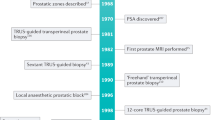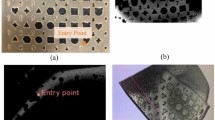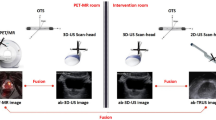Abstract
Improvements in imaging and device engineering have led to the rapid development of advanced, minimally invasive techniques in urologic care. While imaging advances have had a major effect in the areas of diagnosis, surgical planning and therapeutic assessment, the focus of this Review is on developments in intraoperative imaging that are currently making an impact in urology and are likely to provide additional opportunities to urologists in the years to come. While previous image-guided urologic procedures have mostly utilized two-dimensional X-ray images, it is expected that new technologies will involve the use of three- and four-dimensional multi-modality imaging, molecular imaging, and robot-assisted image-guidance techniques. Application of these procedures will bring together the complementary disciplines of endourology and interventional radiology in the development of multidisciplinary, cooperative approaches to providing optimal treatments and outcomes for urologic disease.
Key Points
-
Advances in imaging are having an increasing role in guiding procedures and operations in urologic diseases
-
New rotational fluoroscopy with fluoroscopic C-arms can create CT-like images to guide procedures
-
Endoscopic ultrasonography, ultrasound contrast agents and 4D imaging can improve visualization to help guide therapies
-
Real-time CT imaging offers 'live' CT to guide procedures
-
Thermal monitoring with MRI can provide feedback for thermal ablation procedures
-
Molecular imaging will provide more specific and physiologic information to guide procedures
This is a preview of subscription content, access via your institution
Access options
Subscribe to this journal
Receive 12 print issues and online access
$209.00 per year
only $17.42 per issue
Buy this article
- Purchase on Springer Link
- Instant access to full article PDF
Prices may be subject to local taxes which are calculated during checkout


Similar content being viewed by others
References
Hellawell GO et al. (2005) Radiation exposure and the urologist: what are the risks? J Urol 174: 948–952
Valentin J (2000) Avoidance of radiation injuries from medical interventional procedures. Ann ICRP 30: 7–67
Yusuf TE et al. (2006) International survey of knowledge of indications for EUS. Gastrointest Endosc 63: 107–111
Kondabolu S et al. (2004) The role of endoluminal ultrasonography in urology: current perspectives. Int Braz J Urol 30: 96–101
Horiuchi K et al. (2000) High-frequency endoluminal ultrasonography for staging transitional cell carcinoma of the bladder. Urology 56: 404–407
Saga Y et al. (2004) Comparative study of novel endoluminal ultrasonography and conventional transurethral ultrasonography in staging of bladder cancer. Int J Urol 11: 597–601
Mitterberger M et al. (2006) Dynamic transurethral sonography and 3-dimensional reconstruction of the rhabdosphincter and urethra: initial experience in continent and incontinent women. J Ultrasound Med 25: 315–320
Kolecki R and Schirmer B (1998) Intraoperative and laparoscopic ultrasound. Surg Clin North Am 78: 251–271
Gilbert BR et al. (1988) Intraoperative sonography: application in renal cell carcinoma. J Urol 139: 582–584
Campbell SC et al. (1996) Intraoperative evaluation of renal cell carcinoma: a prospective study of the role of ultrasonography and histopathological frozen sections. J Urol 155: 1191–1195
Choyke PL et al. (2001) Intraoperative ultrasound during renal parenchymal sparing surgery for hereditary renal cancers: a 10-year experience. J Urol 165: 397–400
Ukimura O et al. (2006) Real-time transrectal ultrasound guidance during laparoscopic radical prostatectomy: impact on surgical margins. J Urol 175: 1304–1310
Lees W (2001) Ultrasound imaging in three and four dimensions. Semin Ultrasound CT MR 22: 85–105
Claudon M et al. (2002) Advances in ultrasound. Eur Radiol 12: 7–18
Mitterberger M et al. (2007) Three-dimensional ultrasonography of the urinary bladder: preliminary experience of assessment in patients with haematuria. BJU Int 99: 111–116
Dolkart L et al. (2005) Four-dimensional ultrasonographic guidance for invasive obstetric procedures. J Ultrasound Med 24: 1261–1266
Johnson DB et al. (2005) Contrast-enhanced ultrasound evaluation of radiofrequency ablation of the kidney: reliable imaging of the thermolesion. J Endourol 19: 248–252
Halpern EJ et al. (2005) Detection of prostate carcinoma with contrast-enhanced sonography using intermittent harmonic imaging. Cancer 104: 2373–2383
Pelzer A et al. (2005) Prostate cancer detection in men with prostate specific antigen 4 to 10 ng/ml using a combined approach of contrast enhanced color Doppler targeted and systematic biopsy. J Urol 173: 1926–1929
Haag P et al. (2006) Microbubble-enhanced ultrasound to deliver an antisense oligodeoxynucleotide targeting the human androgen receptor into prostate tumours. J Steroid Biochem Mol Biol 102: 103–113
Daly B and Templeton PA (1999) Real-time CT fluoroscopy: evolution of an interventional tool. Radiology 211: 309–315
Keat N (2001) Real-time CT and CT fluoroscopy. Br J Radiol 74: 1088–1090
Katada K et al. (1996) Guidance with real-time CT fluoroscopy: early clinical experience. Radiology 200: 851–856
Heck SL et al. (2006) Accuracy and complications in computed tomography fluoroscopy-guided needle biopsies of lung masses. Eur Radiol 16: 1387–1392
Daly B et al. (1999) Percutaneous abdominal and pelvic interventional procedures using CT fluoroscopy guidance. AJR Am J Roentgenol 173: 637–644
Gupta A et al. (2006) Computerized tomography guided percutaneous renal cryoablation with the patient under conscious sedation: initial clinical experience. J Urol 175: 447–452
Silverman SG et al. (1999) CT fluoroscopy-guided abdominal interventions: techniques, results, and radiation exposure. Radiology 212: 673–681
Nazarian S et al. (2006) Clinical utility and safety of a protocol for noncardiac and cardiac magnetic resonance imaging of patients with permanent pacemakers and implantable-cardioverter defibrillators at 1.5 tesla. Circulation 114: 1277–1284
Chan DY et al. (2001) Image-guided therapy in urology. J Endourol 15: 105–110
Rickers C et al. (2005) Cardiovascular interventional MR imaging: a new road for therapy and repair in the heart. Magn Reson Imaging Clin N Am 13: 465–479
Hama Y et al. (2007) MR lymphangiography using dendrimer-based contrast agents: a comparison at 1.5 T and 3.0T. Magn Reson Med 57: 431–436
Silverman SG et al. (2005) Renal tumors: MR imaging-guided percutaneous cryotherapy–initial experience in 23 patients. Radiology 236: 716–724
Denis de Senneville B et al. (2005) Magnetic resonance temperature imaging. Int J Hyperthermia 21: 515–531
Germain D et al. (2001) MR monitoring of tumour therapy. MAGMA 13: 47–59
Krieger A et al. (2005) Design of a novel MRI compatible manipulator for image guided prostate interventions. IEEE Trans Biomed Eng 52: 306–313
Muntener M et al. (2006) Magnetic resonance imaging compatible robotic system for fully automated brachytherapy seed placement. Urology 68: 1313–1317
Anastasiadis AG et al. (2006) MRI-guided biopsy of the prostate increases diagnostic performance in men with elevated or increasing PSA levels after previous negative TRUS biopsies. Eur Urol 50: 738–748
Barnes AS et al. (2005) Magnetic resonance spectroscopy-guided transperineal prostate biopsy and brachytherapy for recurrent prostate cancer. Urology 66: 1319
Ménard C et al. (2005) An interventional magnetic resonance imaging technique for the molecular characterization of intraprostatic dynamic contrast enhancement. Mol Imaging 4: 63–66
Susil RC et al. (2006) Transrectal prostate biopsy and fiducial marker placement in a standard 1.5T magnetic resonance imaging scanner. J Urol 175: 113–120
Schöder H and Larson SM (2004) Positron emission tomography for prostate, bladder, and renal cancer. Semin Nucl Med 34: 274–292
Li G et al. (2006) The use of MN/CA9 gene expression in identifying malignant solid renal tumors. Eur Urol 49: 401–405
Atkins M et al. (2005) Carbonic anhydrase IX expression predicts outcome of interleukin 2 therapy for renal cancer. Clin Cancer Res 11: 3714–3721
Solomon SB (1999) Interactive images in the operating room. J Endourol 13: 471–475
Author information
Authors and Affiliations
Corresponding author
Ethics declarations
Competing interests
Stephen B Solomon has received grant/research support from General Electric.
Jonathan Coleman and Rodrigo Nascimento declared no competing interests.
Rights and permissions
About this article
Cite this article
Coleman, J., Nascimento, R. & Solomon, S. Advances in imaging for urologic procedures. Nat Rev Urol 4, 498–504 (2007). https://doi.org/10.1038/ncpuro0883
Received:
Accepted:
Issue Date:
DOI: https://doi.org/10.1038/ncpuro0883
This article is cited by
-
Ex vivo assessment of polyol coated-iron oxide nanoparticles for MRI diagnosis applications: toxicological and MRI contrast enhancement effects
Journal of Nanoparticle Research (2014)



